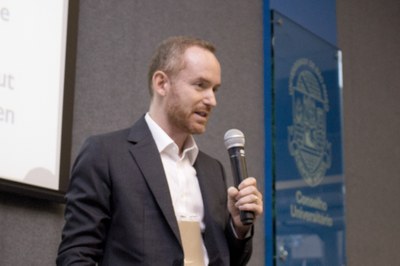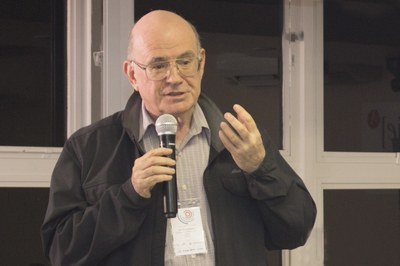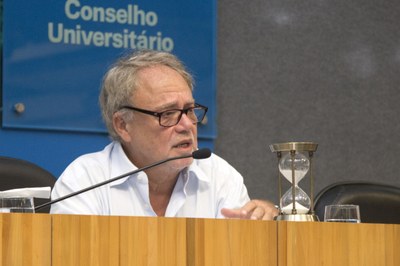Science as academic mythology: Metaphors that bridges time and temporalities
São Paulo, April 28, 2015
Science and myth are two words that have emerged several times during the first week of work at the ICA in São Paulo. Fifteen talks with different senior researchers, from different Universities and countries, have spread out a huge range of fields of knowledge and gave the initial stimulus to the discussion sessions of the thirteen participants.
 From the first talk, Matt Kleban’s Cosmic History and Time’s Arrow, we have learned how astrophysics has conceived the cosmological history of the universe based on different theories of the Big Bang, discussing where the “beginning” of time was and the arrow’s model implications with graphs. These images have reminded how metaphors are so important in mythology as in science. From anthropology, the “cosmology” of any culture is based on their world views, the ideas and imaginaries that define their notion of existence and sense in life. Talks about origin and destiny are, punctually, structural aspects of cosmogony myths. Myths talk about origins and destinies, birth and death, past and present. So why does science have a unique field of research called “cosmology” that is responsible to address this kind of topic? And why is cosmology supposed to be “the truth” and the ultimate word about the beginning and the destiny of our society? Is it possible to conceive scientific cosmology as a contemporary academic mythology?
From the first talk, Matt Kleban’s Cosmic History and Time’s Arrow, we have learned how astrophysics has conceived the cosmological history of the universe based on different theories of the Big Bang, discussing where the “beginning” of time was and the arrow’s model implications with graphs. These images have reminded how metaphors are so important in mythology as in science. From anthropology, the “cosmology” of any culture is based on their world views, the ideas and imaginaries that define their notion of existence and sense in life. Talks about origin and destiny are, punctually, structural aspects of cosmogony myths. Myths talk about origins and destinies, birth and death, past and present. So why does science have a unique field of research called “cosmology” that is responsible to address this kind of topic? And why is cosmology supposed to be “the truth” and the ultimate word about the beginning and the destiny of our society? Is it possible to conceive scientific cosmology as a contemporary academic mythology?
If we look at the theory of the Big Bang, for instance, it consummates the basic elements of a myth. This cosmological theory has mythical images like the “bang”, an initial explosion or ignition that begins everything, the idea of a beginning of the Universe or a world, marked in a distant non-human place (the theory assigns this moment to 14.3 million years ago). These are typical elements of the origin of the universe in several mythologies. Cosmology conceived as a discourse, as a narrative, is constructed based on creation metaphors. The digital and animated graphs, usually used to explain this theory, are for scientist like sacred symbols that summarize the whole theory, as ancient civilizations had for explaining their cosmogonies (cylinders in Sumer, papyrus in Egypt, statues in Rome, mandalas in India, pyramids in Maya societies, body tattoos and textile design in aboriginal societies, just to mention a few).
 Eliezer Rabinovici’s talk, Constructing Time In Physics- Attempts, has shown us how physicists have been attempting to understand the experience of a time and its flow, comparing studies of large and small time scales. In his presentation, he showed biblical texts and mythical images, like the Goya’s painting of the Greek myth of Chrono eating his son. Cosmogonic metaphors are usually used in physics to deal with the cosmological problems. A well-known metaphor, “God doesn’t play dices with the world”, was used by Einstein to respond the question whether reality is deterministic or stochastic. Scientific and mythically rooted metaphors allow us to understand binary contradictions and go beyond a dichotomous rationality. Scientific theories coming from different fields incorporate external and intangible characters in their models like if they were heroes or gods, a central element in the architecture of myths all around the world. The “gravity”, the “light”, the “space” and of course the “time”, are treated as Tlaloc, Viracocha, Thot, Baitogogo or other mythical heroes that sometimes represent these cosmic forces and sometimes are the vehicles of them.
Eliezer Rabinovici’s talk, Constructing Time In Physics- Attempts, has shown us how physicists have been attempting to understand the experience of a time and its flow, comparing studies of large and small time scales. In his presentation, he showed biblical texts and mythical images, like the Goya’s painting of the Greek myth of Chrono eating his son. Cosmogonic metaphors are usually used in physics to deal with the cosmological problems. A well-known metaphor, “God doesn’t play dices with the world”, was used by Einstein to respond the question whether reality is deterministic or stochastic. Scientific and mythically rooted metaphors allow us to understand binary contradictions and go beyond a dichotomous rationality. Scientific theories coming from different fields incorporate external and intangible characters in their models like if they were heroes or gods, a central element in the architecture of myths all around the world. The “gravity”, the “light”, the “space” and of course the “time”, are treated as Tlaloc, Viracocha, Thot, Baitogogo or other mythical heroes that sometimes represent these cosmic forces and sometimes are the vehicles of them.
Laymert Garcia Dos Santos’s talk about Myth and Technoscience in Transcultural Amazonas has presented another interesting example to think mythology and science, connecting shamanism to techno-scientific culture. In this experiment, called the Opera Amazonas: Music Theatre in Three Parts, Dos Santos has made an artistic bridge between two worlds, the magic one and the digital one. Dos Santos explained two ideas of virtuality, the visions and hallucinations of the shamans in trance (internal, non-material and intangible embodiment), and the visions of the producers of the Opera, who have created an artistic performance of the inaccessible world of shamans (external, material and tangible embodiment).

 Another excellent exposition was given by Leopold Nosek, who talked about Time and subjectivy, connecting the myth with birth. Based on Freud’s psychology, Nosek proposed that “birth” is in direct connection with the conscience of the self, and exemplified that the memory is happening now, not in the past. The passage from the myth (atemporal) to the birth is a beginning, a start of conscience of self. Looking forward how we apprehend time, Nosek read some literature examples of Thomas Mann, who invocates the passage from atemporality to the awareness of time; a process that could be understood as the passage from a myth-logic to science-logic.
Another excellent exposition was given by Leopold Nosek, who talked about Time and subjectivy, connecting the myth with birth. Based on Freud’s psychology, Nosek proposed that “birth” is in direct connection with the conscience of the self, and exemplified that the memory is happening now, not in the past. The passage from the myth (atemporal) to the birth is a beginning, a start of conscience of self. Looking forward how we apprehend time, Nosek read some literature examples of Thomas Mann, who invocates the passage from atemporality to the awareness of time; a process that could be understood as the passage from a myth-logic to science-logic.
The Intercontinental Academia invites us to reflect on our scientific praxis, to rethink our deep conventions, and to contemplate that metaphors, symbols and myths are basic elements in the construction of identities and paradigms. Academic metaphors of time create the bridge among different scientific temporalities. With a specific language and based on its certainties, contemporary science provides protection to the mystery of the existence and time, as mythology did and some cultures still continue to do.
